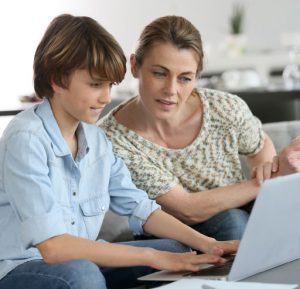Download a printable copy of this article (PDF 414KB)
 The first thing you need to do when contemplating stepping into your child’s online experience is to ask yourself whether you should or not. This article gives a resounding yes to that question!
The first thing you need to do when contemplating stepping into your child’s online experience is to ask yourself whether you should or not. This article gives a resounding yes to that question!
Every parent and carer should be determined to be incredibly nosy about their child’s online activity. If that involves having access to your child’s login details so that you can monitor their online activity . . . then so be it.
If that involves sharing accounts so you know when they’ve been active in certain places, and how active, and the type of activity that they’ve been involving themselves in … then you shouldn’t feel guilt or shame about taking this step.
Many parents and carers, whose children have been in trouble online, report that they wished they’d known more about what their children were up to. It really does stand to reason that knowledge is power when keeping your child safe online.
“At the end of the day, the most overwhelming key to a child’s success is the positive involvement of parents.”
– Jane D. Hull
Here are six approaches to consider when stepping into your child’s online world in a respectful, yet effective, way:
- Discover the internet together.
For parents and carers of young children particularly, this helps them to avoid finding the pitfalls of the internet on their own. It’s better to allow them to discover these pitfalls with a supportive person sitting next to them. Explore and browse the internet together. Show them what a Google search can produce and show them the ineffective and useless things that a Google search can also produce. Find safe, enjoyable and engaging websites at their age level together. - Agree on the rules of engagement.
This means discussing together the when of the internet, the time allocation that will be allowed in your household, the type of behaviour that is acceptable, the types of sites that you will and won’t allow access to, and the rules that apply specifically to sharing personal information online. This should include clear guidelines about which information about themselves is appropriate to share, and which information about themselves is unsafe to share with people they have not yet met face to face. - Discuss fake friends.
Make it clear to your children that there are people in the online world who will represent themselves as somebody they are not. Ask them about how they would know if a person was not who they claimed to be and point out how difficult that really is. Once children have realised this, they will often decide for themselves that the safest assumption they can make about online friends is that they could be fake. Point out the differences in conduct between friends who might be fakes and those that we know and trust and see regularly. - Let your children show you what they’re doing online.
It’s very important for children to get affirmation from their parents about positive behaviour and positive activities online. When they complete a game that you’ve agreed is safe, achieving a high score or a personal best in that game, it’s important that they can bring the device over to you and get a pat on the back for a job well done. You’re actually giving them a pat on the back for engaging in the internet positively … they’re just taking it as a pat on the back for killing a thousand aliens! Either way, we are rewarding positive behaviour in the online realm of their lives. - Encourage ‘cognitive load management’.
This is a technical skill, but is also very important for young people to develop. There is an enormous amount of information available online, and it’s essential to have a strong filter for what’s useless and what’s useful. Practise some Google searches about very generic topics and help them decipher the valuable from the worthless, as if they were completing a school project on this topic. - Stay positive about the internet.
The more you refer to the internet as a dangerous, as a fearful, as an awful place … the more you encourage your child to take their online behaviour underground and to disengage you from their online world. The internet need not be known as a dark threat, but as something that can be a wonderful tool not only for your children in their lives, but for you, too. When you’re positive about the internet, your children are likely to share more with you about their activity on it.
For more information please have a look on the Office of the eSafety Commissioner website as well as on the Bullying. No Way! Website. These websites provide a range of helpful resources.


